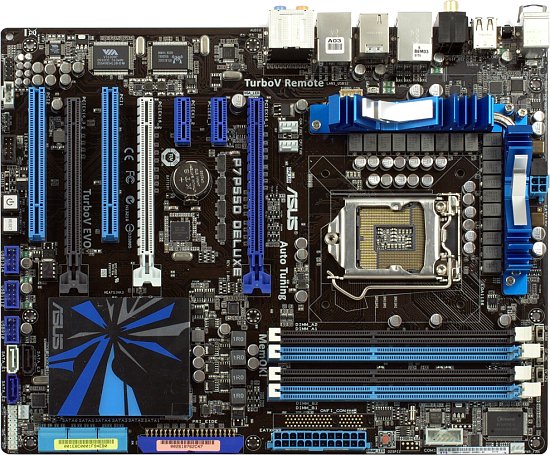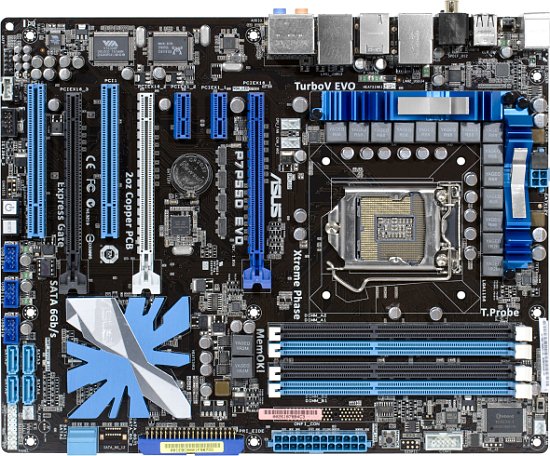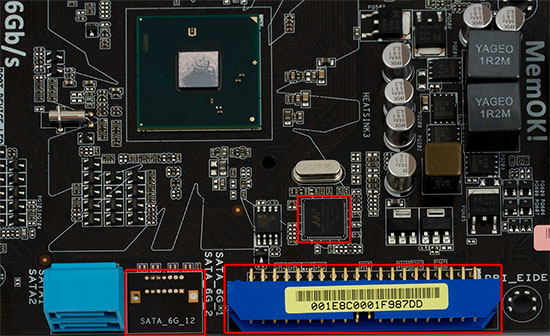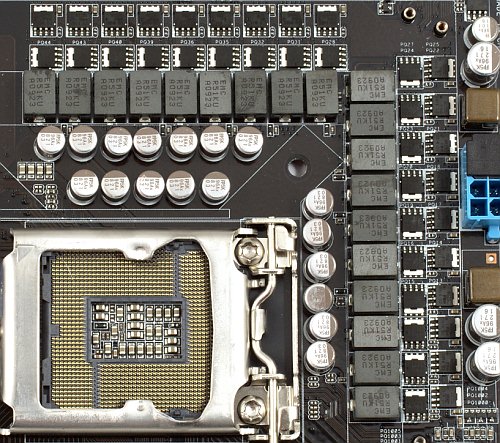As usual, ASUS prepared an entire series of motherboards based on the new chipset -- Intel P55. This series is named P7P55D (we examined several motherboards from the previous popular series P5Q based on the P45 chipset), and it certainly includes expensive top models (Deluxe and Premium) as well as cheap regular models (LE and LX). Today we are going to examine two motherboards -- a "regular" top motherboard P7P55D Deluxe and an unusual P7P55D EVO. The EVO product should have supported the new generation of Serial ATA -- SATA-III with 600-MB/s ports. However, when the P7P55D announcement date grew near, there were detected some problems with the Marvell 88SE9123 controller, and P7P55D EVO (like many other models, including Deluxe) abandoned Serial ATA 3.0, which makes it a mediocre motherboard slightly better than Mid-End.
Design
We are going to examine P7P55D Deluxe here. Now what concerns the second motherboard. As our sample was not of the final design, and had no significant differences from the Deluxe model, we decided to publish only brief comments on P7P55D EVO.


This PCB has the standard design without radical changes. The first thing you notice is a more complex CPU power circuit, bit the cooling system is quite simple. With a great effort of will the marketing department gave up the idea of using a floppy controller on this top motherboard, but the IDE slot is present, of course, as well as COM. Besides, the set of expansion slots is not that scary: for graphics cards, including SLI or CrossFire support, there are two normal PCIEx16 slots (PCI-E 2.0) operating as x16 or x8+x8 owing to the controller in a processor. Besides, there is one PCIEx16 slot (formally, it's also PCI-E 2.0), but it actually works as PCI-E 1.0 x4 (based on the chipset). The chipset provides another two PCIEx1 slots and 2 x PCI. At least one of PCIs should be available, even if you install two graphics cards. And finally, take a look at a new feature from ASUS: latches on DIMM slots do not have moving parts on one end, so you won't have to remove a neighboring graphics card to remove memory modules.
 ASUS P7P55D EVO, preliminary design
ASUS P7P55D EVO, preliminary design
Let's say a few words about the situation with SATA-III. For top models based on Intel P55, all leading motherboard manufacturers prepared PCB designs with a certain controller for this interface (Marvell 88SE9123). However, there were found some problems with this controller in summer. We got contradictory information about these problems: whether they were of the software or hardware nature; whether SATA speed was insufficient or PATA port was inoperable; some people also mentioned instabilities and insufficient number of non-defective chips. Speaking of PATA, it's not a misprint: as Intel chipsets have been stripped of this interface long ago, and motherboard manufacturers are not yet ready to give it up on a mass scale, they install a corresponding additional controller. And manufacturers are interested in combined controllers, of course (SATA/PATA, FireWire/PATA…) -- it simplified PCB layouts. What concerns Marvell 88SE9123, it offers two SATA-600 ports and one IDE. So motherboard designed for this controller had no other PATA controllers.
This way or another, they had to wait for a new revision of the notorious controller. It was decided to abandon Marvell 88SE9123 in the first wave of motherboards, PATA support was provided by another controller, selected in a hurry. SATA-III support was promised in second-wave motherboards. And there will be specific solutions offered in special cases. For example, ASRock bundles the P55 Deluxe with a PCIEx1 expansion card (Marvell 88SE9123) offering two SATA-600 ports. Besides, you can win this expansion card in a lottery on the official web site of the company. ASUS demonstrates a more interesting approach: the top model in this series (P7P55D Premium) preserves the onboard implementation of Serial ATA 3.0. It's provided by an interface (to the chipset) with the increased throughput appropriate for SATA-600. We'll describe this implementation is detail in a corresponding review.
 SATA-III circuitry on the preliminary design of P7P55D EVO
SATA-III circuitry on the preliminary design of P7P55D EVO
Examination of our P7P55D EVO reveals another interesting moment. This motherboard revision has been already stripped of SATA-600 ports, but its PCB layout hasn't been modified: it still has a place for a rack with two such ports, labels on the board, and a seat for this controller. What has been Marvell 88SE9123 replaced with? Manufacturers try to make practically all models of peripheral controllers compatible in layout (within a series of a given manufacturer, of course), which helps segment the line of motherboards without changing their design: a top model is equipped with a top controller plus all ports and expansion slots, while low models come with simpler controllers and only some of the connectors.
Most interestingly, it's the Marvell 88SE9123 on this board! We cannot say for sure whether it's a new revision of the controller (note the last number in the second line -- 5, while it was "4" in the earlier revisions), or disabled SATA functionality (don't forget about missing ports) that allows this controller to work well in the PATA only mode. We've thoroughly tested this implementation of PATA and found no problems with booting from IDE devices or operating speed. However, if we get back to real samples in computer stores, the EVO features the same replacement as the Deluxe: Marvell 88SE9123 (and its two SATA600 ports + one ATA133) is replaced with a couple of controllers JMicron JMB363 + JMB322, providing two SATA300 ports supporting RAID, one SATA300 for eSATA support (in P7P55D EVO it's implemented as a eSATA port on the rear panel), and one ATA133.
 CPU power circuitry on ASUS P7P55D Deluxe
CPU power circuitry on ASUS P7P55D Deluxe
CPU voltage regulator offers 16 phases for the processor core and three phases for Uncore (including the memory controller) with two MOSFETs per phase; power converter for memory modules has three phases. We cannot say that this number of phases is chosen after some calculations -- the minimum number of phases is four for the entire processor (like in cheap models from this series). On the other hand, the increased number of phases should theoretically provide higher voltage stability even in the overclocked mode with higher currents. A certain implementation is chosen solely for marketing reasons -- for one, it shouldn't be worse than in competing products; for two, it depends on how high a products stands in its series: 32+3 phases in the Premium model, 16+3 -- in the Deluxe, and so forth.
Write a comment below. No registration needed!
